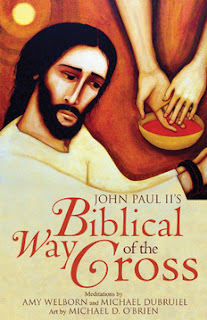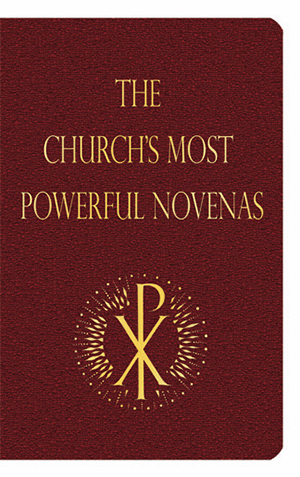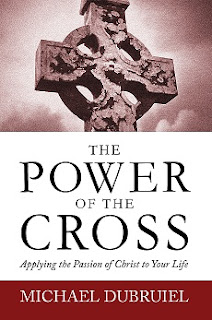The Cross of Christ Illumines. . . Blindness “ by Michael Dubruiel
As I made my journey and drew near to Damascus, about noon a great light from heaven suddenly shone about me. And I fell to the ground and heard a voice saying to me, ‘Saul, Saul, why do you persecute me?’ And I answered ‘Who are you, Lord?’ And he said to me, ‘I am Jesus of Nazareth whom you are persecuting.” Now those who were with me saw the light but did not hear the voice of the one who was speaking to me. And I said, ‘What shall I do, Lord?’ And the Lord said to me, ‘Rise, and go to Damascus, and you will be told all that is appointed for you to do.’ And when I could not see because of the brightness of that light, I was led by the hand by those who were with me, and came into Damascus.” ACTS 22:6–11
Jesus said, “For Judgment I came into this world, that those who do not see may see, and that those who see may become blind.” Some of the Pharisees near him heard this, and they said to him, “Are we also blind?” Jesus said to them, “If you were blind, you would have no guilt; but now that you say, ‘We see,’ your guilt remains.” JOHN 9:39–41
The most unique Holy Saturday I ever experienced occurred when my wife and I decided to go to a monastery for Holy Week . Saturday was a rainy day and we decided to go to a nearby spot that was advertised up and down the interstate as the place to visit when you were passing through this part of the country— it was a cave. What better spot to spend Holy Saturday, I reasoned, than under the earth? After all, Jesus’ body had lain in a tomb on that first Holy Saturday.
So we drove a few miles away from the monastery and joined a group of other travelers in an out-of-the-way location to descend into the earth and explore one of nature’s wonders. What I remember most about the tour of the cave had little to do with the stalactites or the stalagmites but something else that we experienced once we had gone deep into the cave. The tour guide asked us, “How many of you think you have experienced total darkness?” A few people raised their hands. He then told us that he was going to turn off the artificial lighting that illuminated the cave so that we could experience what the first people who had discovered this cave experienced when their light went out. There was nothing but total, pitch darkness. I held my hand in front of my face but could see absolutely nothing. I knew that it was there because I could sense it but I could see absolutely nothing, no shadow, no outline—just a horrible darkness. It was the closest that I have ever come to having some understanding of what it must be like to be totally blind.
In Pilgrim at Tinker Creek, in a chapter entitled “Seeing,” Annie Dillard wrote about people born blind whose sight was restored by a medical procedure. The reaction of those thus healed wasn’t what one might expect. Some wanted to go back to the darkness—they found the light too much. Others enjoyed the gift of vision, but to those who had been in darkness since birth it seemed to them that everything was made of light. Blinded by the Light In John’s Gospel, Jesus divides the world into two camps: those who encounter his light and have their sight restored, and those who encounter that light and are blinded. Jesus told Nicodemus, “And this is the judgment, that the light has come into the world, and men loved darkness rather than light, because their deeds were evil” (John 3:19).
In John’s Gospel, Jesus heals a blind man, who has not only his physical sight restored but also comes to see that Jesus is worthy of worship. The Pharisees who question the blind man refuse to believe, no matter how much evidence is brought forward to prove that Jesus had healed him. Another Pharisee, Saul of Tarsus, later persecuted the followers of Jesus. While setting out on one such mission, Saul was struck by a light from heaven, and heard the voice of Jesus, the suffering Christ. Saul was blinded on his way to Damascus, where a follower of Jesus healed him. Saul became St. Paul, one of the greatest followers of Christ. The preaching of Paul would focus on the crucified Christ, leading many artists to portray the scene of Paul’s conversion as an encounter with a cross of light.
None of the Pharisees, including Saul, thought that persecuting the followers of Christ was evil; in fact, they thought they were doing the will of God. We all risk falling into the same trap. How well do you and I truly see? Do we see everything made of light? Or do we only partially see reality as it is?
A World Made of Light
There have been times in my life when I have called upon God to save or help me, and God has answered in dramatic ways. At
first I gave thanks for God’s intervention in my life. But with time my inner Pharisee began to question the events: Was God really responsible? There are those who believe that we live in an age when miracles have ceased, but I know better. Miracles abound—we just don’t always recognize them. Those cured of physical blindness perceive the world to be made of light; the same is true of those cured of spiritual blindness. What seemed dark and hopeless suddenly becomes a path to glory. The psalmist reflects this spiritual vision when he prays in perhaps the best-known psalm, “Even though I walk through the valley of the shadow of death, I fear no evil; for thou art with me” (Psalm 23:4). Today there are eye surgeries that allow people to see clearly without corrective lenses. We need the “surgery of the cross” to restore our vision, allowing us to see the world as God sees it. The person filled with the Light perceives light, even in apparent total darkness. As we read in the Gospel of Matthew: “The eye is the lamp of the body. So, if your eye is sound, your whole body will be full of light; but if your eye is not sound, your whole body will be full of darkness. If then the light in you is darkness, how great is the darkness!” (Matthew 6:22–23). Lord Jesus, touch our eyes that we might see!





